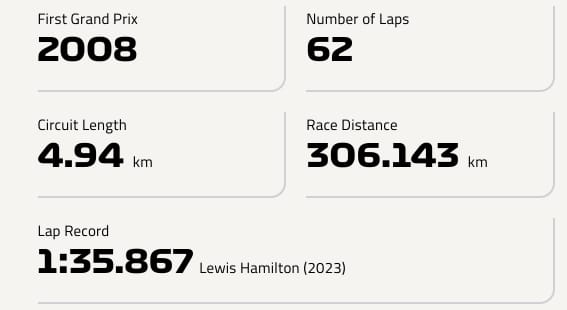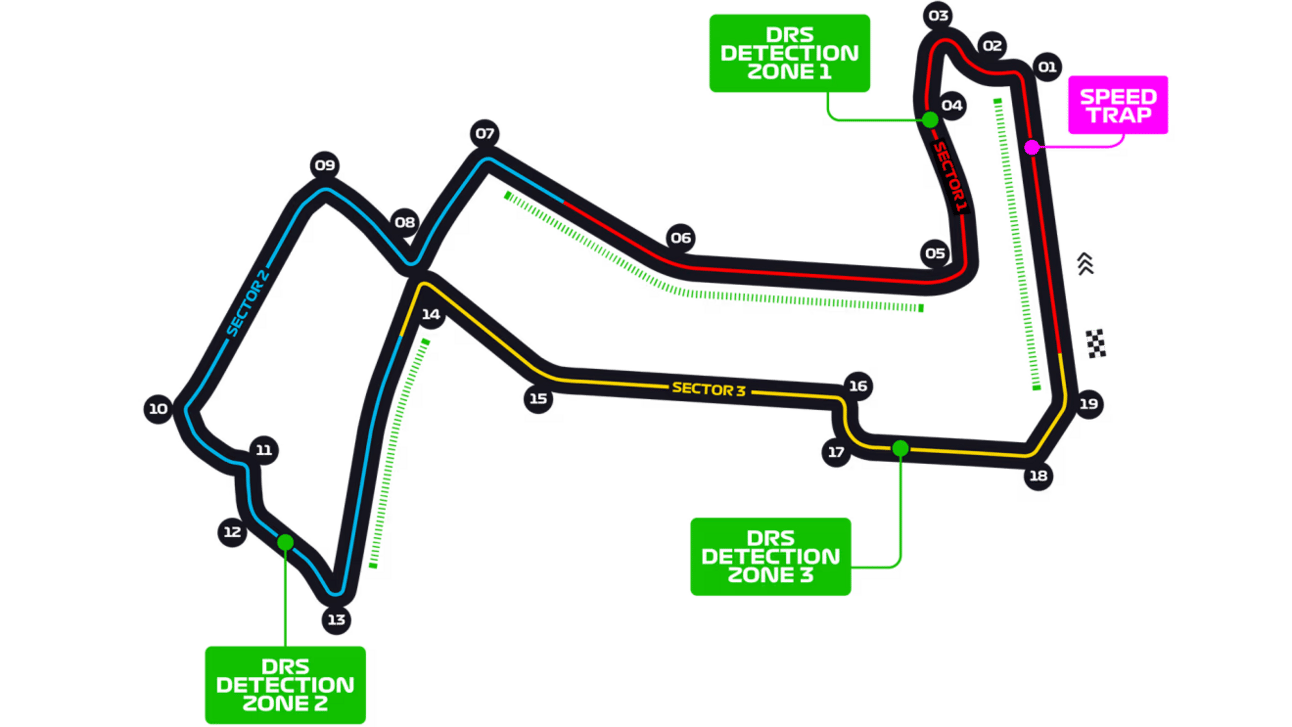- Formula Data Analytics
- Posts
- Singapore GP Preview - Bring the Heat!
Singapore GP Preview - Bring the Heat!
Another Street Circuit With The Temp Cranked Up To 11!

The Singapore Grand Prix, held at the Marina Bay Street Circuit, is one of the most demanding races on the Formula 1 calendar. The circuit is known for its tight corners, frequent braking zones, humid conditions, and night-time spectacle. The track itself consists of 23 corners over 5.063 km (3.146 miles) and is typically divided into three sectors.
Here’s a detailed analysis of each sector of the Marina Bay Circuit:

Singapore GP Summary
Sector Breakdown

Singapore GP Race Track
Sector 1
(Turns 1-7)
Key Features:
Turns 1-3 (The Opening Chicane):
The race begins with a high-speed run into a tight left-right-left sequence of corners. The start can be chaotic, as drivers jostle for position into Turn 1.Turn 1 is a quick left-hand corner where positioning is key to defend or attack.
Turn 2 is an immediate right-hander, and drivers must focus on the line they carry to set up for Turn 3.
Turn 3 (Exit of the Chicane):
A slower left-hand corner, and one of the best overtaking spots on the circuit. The exit is crucial, as it leads to a high-speed straight.Turn 5 (The "Republic Boulevard" straight):
After a short sequence of corners, drivers accelerate towards Turn 5, which exits onto the first DRS zone. The run from Turn 5 down to Turn 7 is one of the few places on the track where cars can reach significant speeds, allowing for overtaking opportunities under DRS.Turn 7 (Heavy Braking):
The end of the straight leads into Turn 7, another key overtaking spot. It requires heavy braking, and the wide entry allows drivers to try a late dive into the corner.
Sector 1 Overview:
This sector is characterized by its medium-speed corners and the first DRS zone. Drivers need to manage traction carefully through the opening sequence and prepare for overtaking or defensive moves into Turn 7. Mistakes in this sector can be costly as the rhythm through Turns 1-3 is crucial.

Corner 1 ,2 & 3
Sector 2
Key Features:
Turn 8 (Tight Right-Hander):
After Turn 7, drivers enter a sequence of 90-degree corners typical of a street circuit. Turn 8 is a tight right-hander requiring precision in braking and throttle application. Overtaking here is possible, but challenging.Turn 9:
A quick left-hander that requires smooth throttle application on exit. Any wheelspin can significantly impact lap time.Turn 10 (The Old "Singapore Sling"):
Previously one of the most infamous chicanes, this corner has been reprofiled into a smoother left-hand bend. It’s still tricky due to the bumps and proximity to the barriers, but much safer than its older version.Turn 11-13 (Around the Esplanade):
A sequence of medium-speed corners that drivers approach carefully. Turn 13 leads onto another short straight and is a key overtaking opportunity under braking. It’s a tight hairpin that challenges the drivers to brake late and maintain speed on exit.
Sector 2 Overview:
This sector is characterized by narrow, twisty sections, which make overtaking difficult. Precision is key, as drivers need to avoid clipping the walls. Smooth throttle management through these slow corners is essential for maintaining good momentum.

Sector 2, Second DRS Dectection
Sector 3
Key Features:
Turn 14 (Tight Right-Hander):
Another heavy braking zone where overtaking is possible. The approach to this corner is fast, and braking stability is crucial. Turn 14 leads into a slower, more technical section.Turns 15 & 16:
Turn 15 is a slight left hander. This is because in 2023 the area of the track was amended to have fewer corners. The Sector 3 chicane towards the end of the lap has been removed. The new map presents a near straight line from turn 15 to 16 (the old Turn 20). Meaning effectively Turns 17 to 19 have been removed. After that, the lap remains the same
Turn 17-19 (The Final Corners):
The final sector features a sequence of slow, technical corners where precision is key. Turn 16 and Turn 17 are especially difficult, as drivers must navigate close to the walls, making no errors. Turn 19 is the final left-hander that exits onto the main straight and prepares the drivers for another lap.
Sector 3 Overview:
This sector is all about precision, with multiple slow corners and no real straights to cool down the tires. The cars are required to have excellent mechanical grip here. It’s easy to make a mistake in this sector, and a misjudgment often leads to contact with the barriers.

Corner 19
Overall Marina Bay Circuit Characteristics:
Braking and Traction: The circuit has some of the highest braking demands on the F1 calendar, especially in the first two sectors. Brake temperatures and tire management are crucial due to the high number of slow corners.
Downforce: This track requires maximum downforce due to the number of corners, and the setup leans towards favoring mechanical grip over outright top speed. The few straights do provide some opportunities to recharge the battery and deploy DRS, but overtaking is difficult due to the narrow nature of the circuit.
Driver Fitness: The hot and humid conditions make this race one of the most physically demanding on the calendar. Drivers have to be at peak fitness to maintain concentration and performance over the course of the long race (often close to the 2-hour limit).
Strategy: Safety cars are common due to the street circuit nature. This plays a huge role in strategy, with teams often opting for undercuts or delayed pit stops to capitalize on potential yellow flags or safety car periods.
Conclusion:
The Marina Bay Street Circuit is a true test of driver skill and team strategy. Its combination of slow corners, high temperatures, and lack of overtaking zones make it one of the most challenging circuits in Formula 1. Each sector presents unique challenges, from the fast, overtaking-friendly Turn 7 in Sector 1, to the twisty, narrow streets in Sector 2, and the high-risk, high-reward final corners in Sector 3.
Watch Last Years Highlights
Race Weekend

Singapore Race Weekend British Summer Time
Lights Out!
Founded in 2020, Advanced SimRacing (ASR) is the fastest-growing North American racing simulation chassis manufacturer and digital motorsport equipment retailer. ASR designs and builds the sturdiest and most durable aluminum profile racing simulation cockpits available in the market today. |   |
W3 Schools is a great platform to learn all kinds of coding languages. The courses are extremely helpful and intuitive. Sitewide 20% Discount With Link. |  |